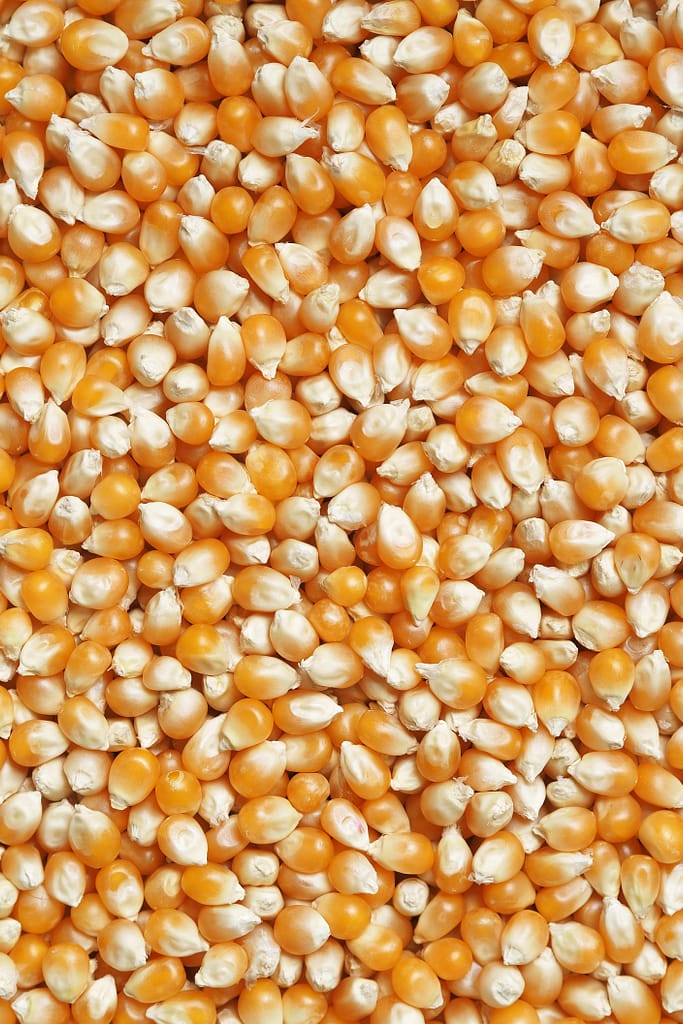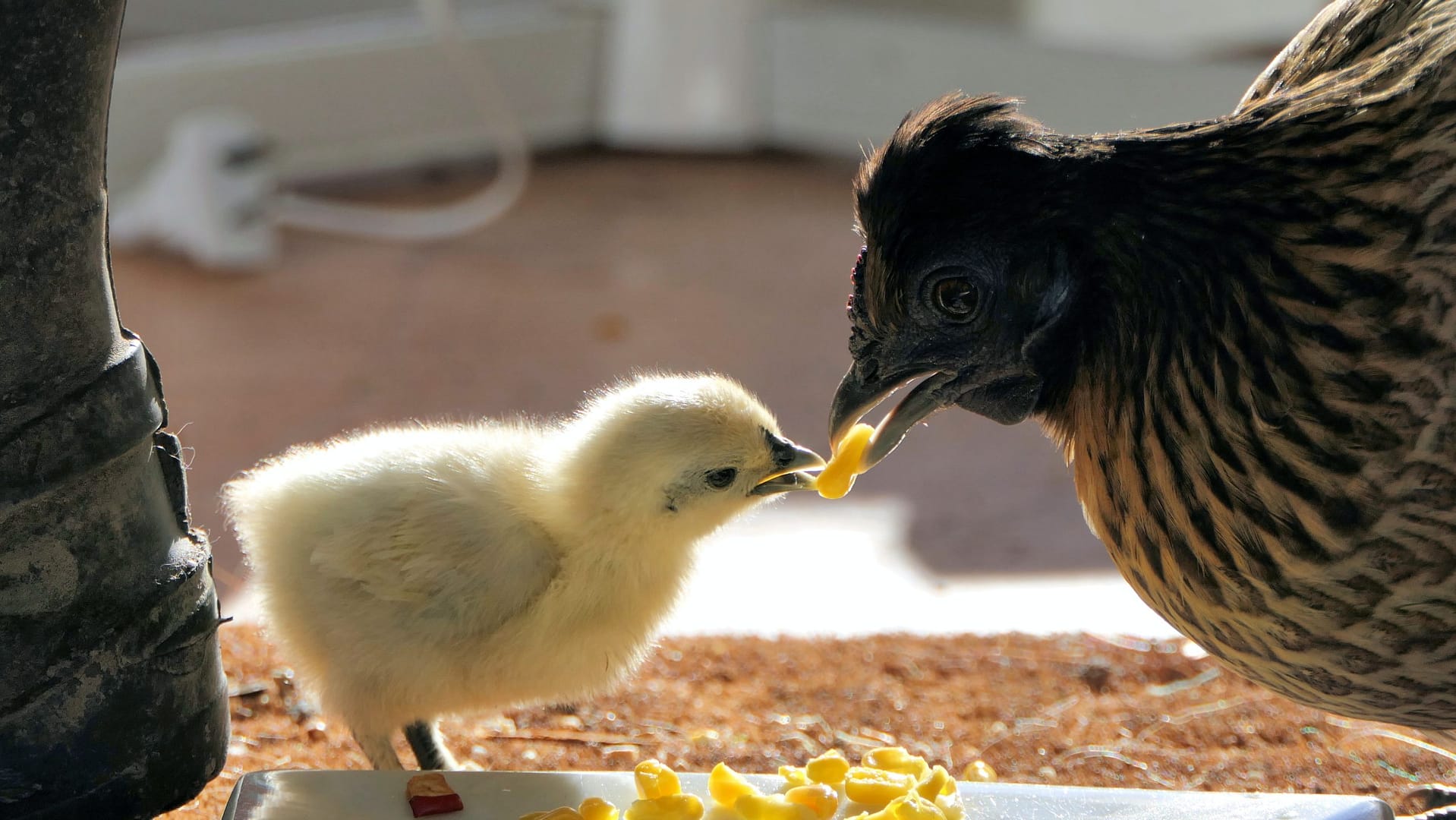Ever wondered the difference between whole vs cracked corn?
Whole corn and cracked corn are both options that can be given to your chickens as treats. Both are loved by chickens, and both provide nutritional value. But which one is better?
First let’s look at general information on dried grain corn before looking at the benefits corn for your flock and the differences in whole vs cracked corn.
What Type of Corn is Used in Chicken Feeds and Scratch?
Most commercial brands of chicken feed and scratch use yellow dent corn, also known as field corn or dented corn. This is the type of corn that’s usually used in corn chips, tortillas, and cornmeal.
The kernels are yellow or orange in hue due to the presence of Carotene (like the stuff in carrots), however, feeding your chickens corn typically won’t make their egg yolks more yellow or orange. Carotene DOES, however, contribute to the yellow color of internal body fat (in both people and chickens).

Nutritional Value of Dried Corn
Despite being known as hard to digest in humans, corn is one of the more digestible grains that your chickens will eat due to the lower fiber content.
The Average Nutritional Content of Corn (from Poultry Extension.org):
- 86% Dry Matter (what remains after the moisture has been evaporated out)
- 7.5% Crude Protein
- 0.18% Methionine
- 0.18% Cysteine
- 0.24% Lysine
- 0.07% Tryptophan
- 0.29% Threonine
- 3.5% Crude Fat
- 1.9% Crude Fiber
- 1.1% Ash (inorganic materials that are a result in the wet milling & dehydration process of corn)
- 0.01% Calcium
- 0.28% Total Phosphorus
- 0.12% Available Phosphorus
(This nutritional information is from Poultry Extension, but they got their data from the Ingredient Analysis Table from Feedstuffs – all links at bottom of post)
Carotene – An unsaturated hydrocarbon which is made by plants, but cannot be produced in animals. Carotenes are essentially pigments produced by plants that assist in photosynthesis and cause a yellow or orange color in some plants: carrots, papaya, mangoes, cantaloupe, red bell pepper, tomatoes, pumpkin, etc.
Besides protein and fats, corn also has:
Carbohydrates in the form of starch & sugars
Minerals such as calcium, copper, iron, magnesium, manganese, phosphorus, potassium, sodium, zinc.
And then vitamins like thiamin, riboflavin, niacin, vitamin B6, folate, and vitamin K.
Corn kernels are made of 4 parts: the Endosperm, Germ, Bran Coat, and Tip Cap. Most of the kernel consists of endosperm and is mostly made of starch. The Germ, which only makes up about 10% of a kernel is where most of the oil is contained. The Bran Coat and Tip Cap contain most of the fiber.
Main Benefits of Providing Corn for your Flock
Health & Nutrition – Corn is a large part of a chicken’s diet and is typically one of the main ingredients in processed store-bought feeds. It provides fiber and protein as well as sugars which are needed for energy.
Above we discussed some of the nutritional value found in dried corn, but here’s what these nutrients can actually do for your chickens.
The amount of dry matter and protein in corn will help your chickens to feel fuller. The protein will also help with their muscle and feather growth. The fats and crabs will provide them with the energy they need to perform daily functions. And the vitamins and minerals will keep them healthier overall and produce delicious eggs.
The fat and energy they get will also build of their fat stores and help keep them warmer during cold weather. Just keep in mind that some extra fat on your chickens’ bones during winter is good, too much is detrimental to their health.
Chickens love it – If you feed your chickens corn (in any form), it will most likely become one of their favorite treats. This comes in handy when training them to come to you when you call them and give them tasty corn kernel treats as a reward. It also serves as entertainment since they’ll enjoy scratching around for kernels.
Added bonus – Corn is relatively cheap and easy to find both in stores and online.
Whole Corn VS Cracked Corn
While chickens can’t really voice their opinions on which they like better, in general they’re going to prefer whole kernel corn since it is larger and easier for them to find and eat – basically it’s less work for them.
Cracked corn often has parts that are completely crushed into power and very small bits that can be a bit wasteful (since the chickens can’t really eat the power) and makes it more difficult for them to notice and pick up with their beaks. As they scratch the ground the small pieces and powered bits will also get tossed into oblivion.
From a behavioral standpoint, cracked corn is better. Smaller bits of food take longer to eat which in turn keeps your chickens busy eating for longer periods of time. Some studies on chicken behaviors suggest that keeping your chickens occupied like this helps prevent behavioral problems such as fighting and pecking at each other (feeding your chickens crumbles instead of pellets accomplishes this as well).
Nutritionally – In the process of being ground into smaller bits and dried, cracked corn tends to lose some of its nutritional value due to oxidation. However, this difference is relatively minimal and won’t have a big impact on your chicken’s health so long as you grind the corn yourself and feed it to your chickens fairly quickly (vs storing it for long periods of time).
One thing to be aware of with whole dried corn kernels is they typically come with the hulls intact. Chickens, like humans, are not able to digest these hulls easily which makes cracked corn a bit easier to digest. Cracked corn is also easier to digest due to the increased surface area.
One danger of feeding your chickens whole corn, is the potential for an impacted crop or blockage in the digestive track. As long as you’re providing your chickens with ample grit and water, they should be fine though.
As you can see, cracked corn and whole corn both have their pros and cons. Which one is better for your chickens will depend on your preferences, the availability of different types of dried corn that you have access to, etc.

How Old do Chickens Need to be to Eat Corn?
Chicks & chickens can eat corn at any age, however, there are a couple things to be aware of when choosing what type of corn to feed them.
Whole corn is too large and difficult for chicks and young chickens to eat. If feeding dried corn to chicks it’s best to feed them cracked corn.
If feeding hard foods such as cracked corn to your chicks, you should also provide them with chick grit to aid in digestion.
Note: All chickens should be provided with grit if they’re eating foods besides commercial feeds. While they can get some grit from foraging around your yard and eating rocks, providing a separate bowl of grit as an option is a good idea.
How Much Corn You Should Feed Your Chickens
Corn should be considered a treat for your chickens and not used as a staple of their diet. Most chicken feeds already contain large amounts of ground corn so providing them a lot of extra corn on the side might be too much and cause an imbalanced diet.
Keep in mind that store-bought chicken feeds are specially formulated to have all of the nutrients that chickens need – anything you provide on top of that could potentially be diluting other nutrients that your chickens need.
A handful of corn for every couple of chickens is fine. You don’t want corn or any other treats to take up more than 10% of their diet.

Why is too Much Corn Bad?
Corn is high in fats and sugar which can lead to your chickens being overweight which will put strain on their legs and can cause issues with mobility.
Consuming corn will also raise the internal temperatures of your chickens. In winter this can be a good way of keeping your chickens warmer, but during the hottest parts of summer it could be detrimental to their health.
Remember: Corn (and other treats) in moderation is best!
Where to Buy Whole and Cracked Corn
Feed stores meant for poultry and livestock will almost always have corn in some kind of form. It might be sold in bags by itself or it might be an a bag of mixed grains, such as scratch. It can also be easily bought off line form various retailers making corn itself fairly accessible.
Do not feed your chickens corn kernels meant for making popcorn as most of the time these are covered in oil and seasonings already and are also more expensive than the bags of corn meant for feeding livestock.
Other Corn Options (non-dried)
While this article is mostly about dried corn, hole corn on the cob bought at the supermarket is also a great option if you want to give your chickens a treat.
You can feed fresh (non-dried) corn to your chickens of any age. While you could also feed them canned corn, it’s often full of sodium and other preservatives so it’s best to stick to fresh off a cob or frozen corn. Frozen corn also makes for a nice cool treat in summer 😊.
Costs of Whole and Cracked Corn
I did some digging around the internet and came up with a couple different prices for whole and cracked corn. Plain whole corn will of course be the cheapest option. Cracked corn, since it’s been processed, will be a bit more expensive (you pay for the labor & tools needed to process it). Organic anything is the most expensive, so organic cracked corn will end up being the priciest option while whole regular corn kernels will be the cheapest.
Whole Feed Corn – 4 LB $14.99 – $1.07 / LB
Cracked Corn – 10 LB $12.98 – $1.30 / LB
Whole Organic Corn – 50 LB $95 – $1.90 / LB
Storing Dried Corn
Store whole corn kernels in their sealed bag in a dark, cool, and dry location. Whole corn when unopened and stored this way can last for many years. If the bag has been opened, it’s best to transfer the kernels to a storage bin with a top that can make the container airtight. If using cracked corn, only buy in small amounts/single bags (don’t buy in bulk) and try to use it up as soon as possible.
Conclusion / Final Notes
In general, corn is very good for your chickens. It provides entertainment as they scratch and pack about for the kernels or cracked pieces.
Both cracked and whole corn are great for your chickens, just keep in mind the size of your chickens and the amounts that you feed them.
Feed your chickens whichever is easiest for you to acquire.
If providing whole corn make sure your chickens have plenty of grit to help them digest it. It’s a good idea to provide your chickens with grit in general (smaller chick grit is available for young-uns).
If you buy scratch for your chickens, it will usually contain cracked corn along with other seeds and grains.
Only give very small amounts in summer. Larger amounts are ok in winter since it will help raise your chickens internal body temperature. About a handful worth per every couple of chickens should be the max though – no more than 10% of their daily diet.
Some chickens are pickier than others and might not like corn.
Too much corn will lead to too much fat in your chickens.
Dried corn, whether cracked or whole can typically be kept for months in a cool and dry environment.
Corn has relatively low natural oil content so it’s not likely to go bad/rancid. However, it’s still best to keep it in a cool and dry environment to prevent mold. It’s also best to keep in a pest-proof container in order to keep out mice or insects.
While cracked corn is easier to digest, the actual risk of impacted crop in adult chickens eating whole corn is very low and doesn’t pose a large risk.
Sprouting whole corn – soak overnight, up to 24 hours drain and leave in a colander until start to sprout. Rinsce/water them occasssionally over a couple days for the sprout to fully appear. (this can be done with whole oats, peas, and lentils as well 😊 Increases protein percentage (not the actual amount though).
Oxidation in cracked corn – We mentioned this earlier, but as soon as corn is cracked or ground, it starts to begin the process of oxidation. Oxidation happens when the cells of the corn kernels are exposed to air which leads to the nutritional value diminishing (but not significantly). If you do want to feed your chickens cracked corn, but want to maximize the nutritional value, it’s best to buy whole kernels and then coarsely grind them yourself and feed to your chickens as soon as possible. If you don’t have a corn grinder (which I’m sure many people don’t), an old blender or coffee bean grinder will do the trick. Just pulse the kernels a little bit at a time so you don’t make them too fine
Resources:
Buy dent corn in bulk that’s organic and non-GMO: PHG means quality (pleasanthillgrain.com)
Dr. Jacob, Jacquire (n.d). “Corn in Poultry Diets,” University of Kentucky. Poultry Extension.org
CORN IN POULTRY DIETS – Small and backyard poultry (extension.org)
Feedstuffs Reference Issue, 2016 Ed. by Amy Batal and Nick Dale, University of Georgia
Feedstuffs Ingredient AnalysisTable 2016_.indd (farmcentric.com)
~*~
If you enjoyed reading this article, please feel free to check out one of our other articles below!
- Common Diseases & Infections in ChickensDiseases in chickens pose significant challenges to chicken owners and poultry farms worldwide. From viral and bacterial infections to parasitic infestations and fungal diseases, chickens are susceptible to a wide range of health conditions that can cause morbidity, mortality, and …
- Key Traits and Characteristics to Consider when Choosing Your ChickensWhen it comes to selecting chickens for your flock, there are several important characteristics to consider. Whether you’re a seasoned poultry keeper or a novice enthusiast, understanding these traits can help you make informed decisions and build a flock that …
- How to Clean Your Chicks’ Water FountCleaning your chicks’ water founts is something that should be done often. Doing so helps keep clean and sanitary water for your chicks to drink which in turn keeps them healthy and helps prevent illnesses. Step 1: Decide where you’re …
- 10 Essential Tips for Keeping Your Chicks’ Water Clean
 Keeping chicks’ water clean is an important part of raising chicks and managing their health and well-being. Raising baby chicks is both a blessing, as well as a messy curse at times. Cute and lovable, though they are, they’re also …
Keeping chicks’ water clean is an important part of raising chicks and managing their health and well-being. Raising baby chicks is both a blessing, as well as a messy curse at times. Cute and lovable, though they are, they’re also … - “Chick Days” are Here!
 We’re more than halfway through February, and that means, “Chick Days” at your local Tractor Supply (or other local feed store) is here! Chick Days, of course, marks the time of year when Tractor Supply starts shipping in a regular …
We’re more than halfway through February, and that means, “Chick Days” at your local Tractor Supply (or other local feed store) is here! Chick Days, of course, marks the time of year when Tractor Supply starts shipping in a regular …

